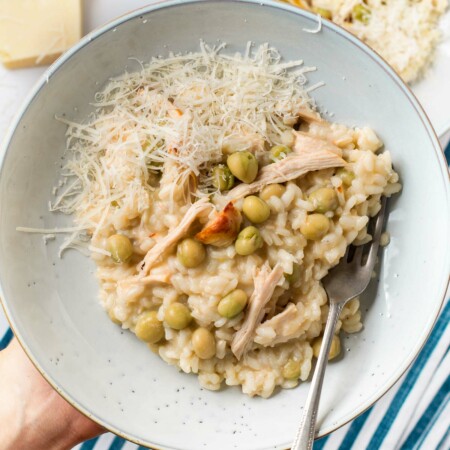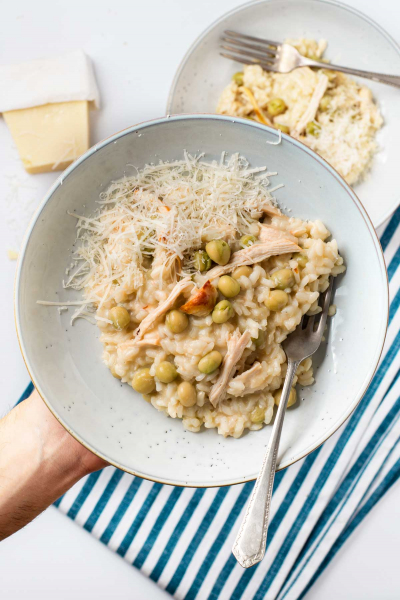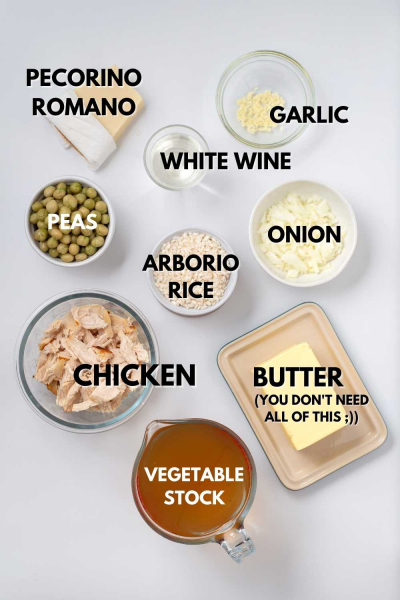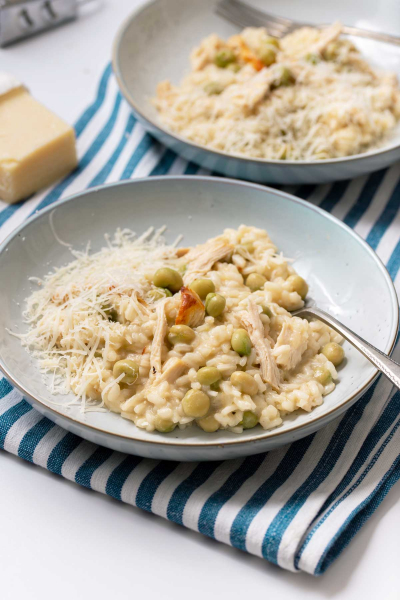This creamy chicken and pea risotto makes a perfect one-pot meal or an elegant side any day of the week. It’s healthy, rich and comforting, and easily ready in just 35 minutes. It’s also naturally gluten-free!
Risotto can be found on fancy menus in posh restaurants, but there’s no need to go to all the trouble to have perfectly amazing risotto at home. It will transform your everyday meals into super delectable.
It’s a hearty dish that only needs a little attention to get the risotto perfectly cooked. Topped with grated fresh parmesan cheese with rotisserie chicken and peas, it just melds together into a perfectly creamy, sensational dish.
I love one-dish meals, like this Baked Ziti with sour cream. It’s zesty, filling and super easy. So when time flies and I’m reaching for something to cook for dinner, it’s always great to have more than one thing in mind.
Ingredients
- Butter
- Yellow onion
- Garlic cloves
- Arborio risotto rice
- White wine
- Unsalted vegetable stock
- Rotisserie-cooked chicken, cut into small pieces
- Frozen peas
- Grana Padano, Parmesan
- Cold butter
- Freshly ground black pepper
How to make risotto
For the full recipe, scroll to the recipe box at the bottom of the page.
- Bring a pot of stock to a boil, then reduce heat and simmer.
- Saute onions until translucent then add minced garlic.
- Stir in arborio rice to lightly toast while stirring frequently.
- Add white wine and cook down until it evaporates.
- Ladle in stock enough to cover the rice, stir and let it absorb.
- Once the liquid is absorbed, add another ladle to cover the rice, stir and let it absorb.
- Repeat until stock is incorporated and rice no longer absorbs the liquid (save 1/2 cup of stock)
- When the rice reaches al dente, add chicken, peas and ladle in more stock.
- Stir to incorporate and heat the cooked chicken and peas.
- Remove from heat, add cold butter, and gently stir to melt the butter. Finish with grated cheese.
- Let it rest loosely covered for a couple of minutes, stir, season and serve.
Risotto is a great dish that can be a little daunting to make at first. Some techniques make it easier, so I suggest reading the tips to get the best risotto you can make.
Tips
- The number one trick to making great risotto is to gently stir the rice throughout the process about every minute or so. Starches are released from the rice giving a creamy texture that makes risotto so rich and luscious.
- The rice actually gets toasted a bit which makes it different in texture and taste. Once you’ve sauteed the onions, add the rice and stir to toast it for about 1 minute before you add the wine. Toasting causes caramelization of the starch in the grains and creates a cooking seal.
- Wine should be added after the toasting of the grains. So, once you get that caramelization, add the wine and let it evaporate before adding the stock.
- Once the rice is a bit translucent, you will want to add the stock a little at a time. You will notice that the rice will start sticking to the pan, and this is the ultimate time to ladle in the stock.
- Use hot stock. You will want to bring the stock to a boil then to a simmer. It’s best to keep the pot on the stove as you ladle in stock to the saute pan with the risotto. Using hot stock means the grains will start to soften and cook immediately.
- Another secret is to ladle in the broth one at a time and let the stock absorb, then repeat once the liquid has absorbed. If you pour it all in at once you will again have a mushy mess.
- Ladle sizes differ, so add enough stock just to cover the rice each time. This way the grains cook evenly. If you don’t cover all of the rice with each ladle, you will have uncooked grains at the top of the pan.
- Unlike cooking other types of rice, you want to stir risotto every few minutes to bring out the starch and make the risotto creamy. Stirring constantly will cool the mix too much and prevent it from cooking evenly. Not stirring it enough, the grains will stick to the pan and won’t be evenly cooked throughout. You want to stir only when you see the rice is drying out, then add more broth.
- Al dente means cooked to be firm to the bite. This means it is soft and cooked through, but with just a small amount of crunch, but not a crackle.
- Once it reaches al dente, add the cold butter, chicken, peas and heat it a bit more. Then remove from the heat and let it rest. You can loosely cover it for 2 to 5 minutes to let the mixture settle. This way it won’t thicken up too much through evaporation and it won’t be too hot to eat.
- Consistency is key to a finished risotto. You should have a loose texture, not a glumpy mush. It should settle after it is stirred. You can add more stock if it seems too dry, or cook it for a bit more if it is too wet.
- You do not need to use heavy cream in this dish. It’s the starches that give it that lovely rich texture. A dab of butter to finish it off will do, and of course, the grated cheese.
How much risotto rice per person?
The general rule is 60 grams per person for a starter, a light meal or if you bulk out the dish with other ingredients like chicken and peas. If you don’t think that is enough, you can use 75 grams per person, but you will need more stock to add to the risotto.
Do I have to use Arborio rice?
There are three types of risotto rice. Risotto rice has enough starch to make a creamy and luscious sauce. The type of rice for making risotto is crucial because it needs enough starch to get that creamy texture, so you can’t use just any type of rice and get the same results.
Italy produces three types of rice perfect for risotto. They differ in size, starch content and texture.
Arborio is short-grain rice and a very popular type for making risotto. It absorbs large amounts of liquid and has a creamy yet heavier texture. I think it is ideal for this dish, but there are others you could experiment with to get the texture and taste you like best.
Carnaroli is a plumper and larger grain of rice with high starch content. It produces an ultra-creamy texture with a nice al dente bite. It holds its shape and makes a good risotto.
Vialone Nano is stubby and thick compared to the other types of rice. It absorbs liquids well and is used mostly with soupy risottos that are usually served with seafood.
What kind of stock should I use?
You have a choice whether to use vegetable stock or chicken stock or broth Using chicken broth will give you a much heartier chicken taste (and you can use the leftovers in this Gluten Free Cream of Mushroom soup)! Vegetable stock is a great choice as it won’t overpower the dish but will add a great taste and nutrition.
I prefer the vegetable stock because the added chicken to this dish tastes naturally good and doesn’t overpower the dish.
Making risotto is not just rice mixed with other ingredients and snap; it’s a great dish. It’s a perfect combination of ingredients and techniques that produces a dish that is as tasty as a finely made risotto.
The stock is just as important as the rice and other ingredients because it pulls out the staches of the rice to make it extra creamy and delicious. The stock should be simmering because the heat ensures an even, continuous cooking.
You want the stock to be flavorful, aromatic, and unsalted. Too much concentration in the stock will overpower the risotto, so it’s best to keep it light and bright.
If you really want to go all out and make the best risotto, you could easily make your own Vegetable Stock. It takes an hour and 10 minutes to make, but it can easily be made ahead of time.
I don’t have rotisserie chicken
That’s ok; you can pre-cook chicken breasts and cut them into small pieces. Just season the chicken with salt and pepper, add it to a pan with a little oil, and gently fry it until it’s cooked through.
And if you have some leftover chicken breast, you could make this great balsamic rosemary chicken!
Do you have to use parmesan cheese?
Traditionally, parmesan cheese has been the cheese used in risotto for ions. Knowing my Italian friends, there is no other cheese to use with risotto as there is a long history and tradition when cooking Italian food.
That being said, there are other types of cheese to use that give you amazing taste profiles and are great in this chicken and pea risotto. Like Grana Padano, it’s a great cheese that makes a cheesier sauce than parmesan.
Really, any hard Italian-style cheese would be good in this dish. If you would like to know more about the different types of cheese you could use, read more from The Kitchn here. Although, no Italian would use a sharp cheddar cheese that is listed in the post, as the author says, “Don’t get caught up in the rules”. 😉
Is risotto healthy?
Risotto is creamy and might seem indulgent, but that doesn’t mean that it’s unhealthy. Arborio rice is packed with more fiber than pasta, and it doesn’t need a heavy cream sauce to be tasty because it does that all on its own.
Arborio rice has protein, vitamins, minerals and carbs all in one tasty dish. It contains about 9 grams of protein per serving, so it’s terrific to help build muscle mass.
It’s also loaded with vitamin A and C and gives you about 12% of your daily dose of vitamins. Plus, it gives you about 45% of the daily requirement of essential nutrients.
It’s easy to digest and helps keep you fit while building muscle mass. So compared to other starchy alternatives, risotto rice is a healthy dish the whole family can enjoy.
Do you have to stir the risotto constantly?
Nope! Stirring it constantly adds air into the risotto which means it cools it down making it gluey. That is not what we want for this amazing dish.
There’s a nice balance to stirring risotto that will give you the best texture and taste. If you don’t stir it enough then it will stick to the bottom of the pan and burn.
Agitating the rice is important, but constantly, no. So, stir often but give it a break. Let the liquids absorb, add more stock, and gently stir again until most of the stock is absorbed and you have al dente risotto.
What about the texture?
The texture of risotto is extremely important to the overall appeal of the dish. You don’t want it gloppy or gooey or wet and soupy.
If you can mold the risotto into a shape, it has been overcooked. It should have body, but not be mushy. It should be dense, but again achieving that delicate balance is the ultimate reward.
Do I need to wash risotto rice?
Nope! If you rinse risotto rice, you will be washing off the starches and that is what makes the dish complete.
Do you cook risotto with the lid on or off?
Unlike most rice dishes, risotto is not cooked with a lid until the very end when the rice is finished.
The only time you want to put the lid loosely on is once it is done for 2 to 5 minutes. This is an important step to making the perfect creamy texture.
Do you have to use wine?
Wine is a signature ingredient in risotto dishes. Wine gives it a hint of flavor and a little acidity to the dish which helps balance the richness.
But, if you forgot the wine and don’t want to go back to the store, you can leave it out and squirt a bit of lemon juice for the acidity.
Can I freeze risotto?
If you are cooking for guests and want to make the risotto ahead of time, you can freeze the risotto and thaw it out later.
Just cook the risotto and let it cool at room temperature. Then freeze it in an airtight container for up to 3 months. Thaw it in the fridge overnight and reheat it in the oven.
In an oven-safe dish with a lid, heat it at 355 °F (180 °C) for about 20 to 30 minutes or until it is piping hot then add the cooked chicken and peas, cheese and serve.
Other one pot recipes
If you’re looking for other easy one-pot meals, check these out:
- Quinoa Pizza Casserole
- Spaghetti Squash Alfredo
- 1 Pot Pasta with Cherry Tomatoes
- Hamburger Helper from Scratch
- Instant Pot Tortellini Soup
- Gnocchi with Lighter Tomato Cream Sauce
What is your favorite one-pot meal?
If you try this Chicken and Pea Risotto, let me know how it went! Snap a pic and tag #FoodDoodlesRecipes so I can be sure to see your fantastic creations!

Chicken and Pea Risotto
Ingredients
- 1 tablespoon (14 grams) unsalted butter
- 1 yellow onion finely diced
- 2 large garlic cloves minced
- 9 ounces (255 grams) arborio risotto rice
- ½ cup (120ml) white wine
- 5 cups (1.2l) vegetable stock
- 9 ounces (255 grams) rotisserie-cooked chicken cut into small pieces
- 7 ounces (200 grams) frozen peas
- ⅓ cup Parmesan, Pecorino Romano or another hard Italian-style cheese, finely grated
- 2 tablespoons cold butter
- freshly ground black pepper
Instructions
- Add the stock to a medium pan over low heat and gently simmer.
- Bring a large saute pan at medium heat, once hot, add the olive oil, onion and cook for 2-3 minutes. Add the garlic, stir and add the arborio rice. Cook, stirring frequently for 1 minute.
- Pour the white wine and stir, allowing the alcohol to evaporates, about 1 minute.
- Pour 1 cup of the stock and stir well with a wooden spoon. Simmer on medium-low heat, uncovered for 5-6 minutes until all liquids were absorbed by the rice.
- Place the pan with stock on the stove next to the risotto saute pan with a ladle.
- Continue to cook the rice by adding a ladle of stock each time the risotto dries out. Stir frequently with a wooden spoon and repeat this process until most of the stock is incorporated into the risotto, about 20 minutes until the rice is al dente. Save about 1/2 cup of the stock.
- Check the consistency of the risotto, the rice should be soft on the outside and gently crunchy in the middle. At this point, add the chicken, peas and another ladle of stock, give a gentle stir to incorporate the new ingredients. Continue to cook to heat the peas and chicken. Remove from the heat.
- Add the cold butter and stir gently but frequently to melt and finish with the grated cheese.
- Season with black pepper and serve immediately.












Leave A Reply!